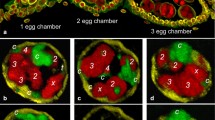Abstract
A map of the mouse oocyte has been constructed utilizing early and mid/late pachytene stages. Each bivalent was clearly identified. At the mid/late stage 195 chromomeres corresponded directly to precursor chromomeres in the early stage, whilst 84 chromomeres were derived from two chromomeres from the early stage. The X and 13 bivalents were found to have a single chromomere in the early stage which later yielded two sites. There were approximately twice as many total chromomeres as mitotic bands, with good correspondence between pachytene chromomeres and major mitotic bands. Application of the use of mapping to a previously reported bivalent bearing a pleiomorphic region is noted.
Similar content being viewed by others
References
Bordjadze, V.K., Prokofieva-Belgovskaya, A.A.: Pachytene analysis of human acrocentric chromosomes. Cytogenetics 10, 38–49 (1971)
Comings, D.E.: Chromosome banding and chromosomal proteins. Human Cytogenetics Vol. 7 (ICN-UCLA Symposium on Molecular and Cellular Biology Ser.; R. Sparkes, et al., eds.), pp. 66–74. New York: Academic Press 1977
Darlington, C.D., La Cour, L.F.: The handling of chromosomes, 4th edit. London: Allen and Unwin 1962
de Torres, M.L., Abrisqueta, J.A.: Study of human male meiosis II-Q-banding in pachytene bivalents. Hum. Genet. 42, 283–289 (1978)
Fletcher, J.M.: Light microscope analysis of meiotic prophase chromosomes by silver staining. Chromosoma (Berl.) 72, 241–248 (1979)
Ford, L., Cacheiro, N., Darwin, N., Heller, C.G.: Identification of normal human pachytene chromosomes. I. The normal human karyotype. Nucleus (Calcutta) 11, 83–95 (1968)
Francke, U., Oliver, N.: Quantitative analysis of high-resolution trypsin-Giemsa bands on human prometaphase chromosomes. Hum. Genet. 45, 137–165 (1978)
Griffen, A.B.: A late pachytene chromosome map of the male mouse. J. Morph. 96, 123–138 (1955)
Hultén, M., Luciani, J.M., Kirton, V., Devictor-Vuillet, M.: The use and limitations of chiasma scoring with reference to human genetic mapping. Cytogenet. Cell Genet. 22, 37–58 (1978)
Hungerford, D.A., Hungerford, A.M.: Chromosome structure and function in man. VI. Pachytene chromomere maps of 16, 17 and 18; pachytene as a reference standard for metaphase banding. Cytogenet. Cell Genet. 21, 212–230 (1978)
ISCN (1978): An International System for Human Cytogenetic Nomenclature (1978). Birth Defects: Original Article Series Vol. XIV, No. 8. New York: The National Foundation 1978 (also in Cytogenet. Cell Genet. 21, 309–404, 1978)
Jagiello, G., Fang, J.S., Turchin, H.A., Lewis, S.E., Gluecksohn-Waelsch, S.: Cytological observations of deletions in pachytene stages of oogenesis and spermatogenesis in the mouse. Chromosoma (Berl.) 58, 377–386 (1976)
Lalley, P.A., Minna, J.D., Francke, U.: Conservation of autosomal gene synteny groups in mouse and man. Nature (Lond.) 274, 160–163 (1978)
Luciani, J.M., Morazzani, M-R., Stahl, A.: Identification of pachytene bivalents in human male meiosis using G-banding technique. Chromosoma (Berl.) 52, 275–282 (1975)
Luciani, J.M., Devictor, M., Morazzani, M.-R., Stahl, A.: Pachytene mapping of the C9 and acrocentric bivalents in the human oocyte. Hum. Genet. 36, 197–204 (1977)
McClintock, B.A.: Cytological and genetical study of triploid maize. Genetics 14, 180–222 (1929)
Moses, M.J., Russell, L.B., Cacheiro, N.L.A.: Mouse chromosome translocations: Visualization and analysis by electron microscopy of the synaptonemal complex. Science 196, 892–894 (1977)
Nesbitt, M.N., Francke, U.: A system of nomenclature for band patterns of mouse chromosomes. Chromosoma (Berl.) 41, 145–158 (1973)
Pathak, S., Hsu, T.C., Markvong, A.: Pachytene mapping of the male Chinese hamster. Cytogenet. Cell Genet. 17, 1–8 (1976)
Rhoades, M.M.: Meiosis in maize. J. Hered. 41, 59–67 (1950)
Slizynski, B.M.: A preliminary pachytene chromosome map of the house mouse. J. Genet. 49, 242–245 (1948)
Slizynski, B.M.: The pachytene stage in mammalian oocytes. Nature (Lond.) 189, 683–684 (1961)
Stock, A.D., Burnham, D.B., Hsu, T.C.: Giemsa banding of meiotic chromosomes with description of a procedure for cytological preparations from solid tissues. Cytogenetics 11, 534–539 (1972)
Unakul, W., Hsu, T.C.: Induction of chromosome banding in early stages of spermatogenesis by ethidium bromide. Chromosoma (Berl.) 44, 285–290 (1973)
Wilson, E.B.: The cell in development and heredity, 3rd edit., pp. 907–912. New York: MacMillan 1925
Yerganian, G.: Cytologic maps of some isolated human pachytene chromosomes. Amer. J. Hum. Genet. 9, 42–54 (1957)
Yunis, J.J., Sawyer, J.R., Ball, D.W.: The characterization of high resolution G-banded chromosomes of man. Chromosoma (Berl.) 67, 293–307 (1978)
Author information
Authors and Affiliations
Rights and permissions
About this article
Cite this article
Jagiello, G., Fang, JS. A Pachytene map of the mouse oocyte. Chromosoma 77, 113–121 (1980). https://doi.org/10.1007/BF00292045
Received:
Accepted:
Issue Date:
DOI: https://doi.org/10.1007/BF00292045




